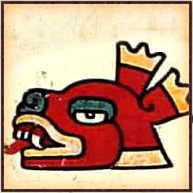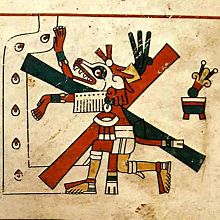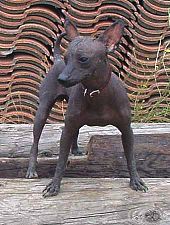Dogs in Mesoamerican folklore and myth

Dogs have occupied a powerful place in Mesoamerican folklore and myth since at least the Classic Period right through to modern times.[1] A common belief across the Mesoamerican region is that a dog carries the newly deceased across a body of water in the afterlife. Dogs appear in underworld scenes painted on Maya pottery dating to the Classic Period and even earlier than this, in the Preclassic, the people of Chupícuaro buried dogs with the dead.[2] In the great Classic Period metropolis of Teotihuacan, 14 human bodies were deposited in a cave, most of them children, together with the bodies of three dogs to guide them on their path to the underworld.[3]
The Xoloitzcuintli is a hairless dog from Mesoamerica. Archaeological evidence has been found in the tombs of the Colima, Mayan, Toltec, Zapotec, and Aztec people dating the breed to over 3500 years ago. Long regarded as guardians and protectors, the indigenous peoples believed that the Xolo would safeguard the home from evil spirits as well as intruders. In ancient times the Xolos were often sacrificed and then buried with their owners to act as guide to the soul on its journey to the underworld. These dogs were considered a great delicacy, and were consumed for sacrificial ceremonies – including marriages and funerals.[4]
In many versions of the 20-day cycle of the Mesoamerican calendar, the tenth day bears the name dog.[5] This is itzcuintli in Nahuatl, the language of the Aztecs, tz'i' in the Kʼicheʼ Maya language and oc in Yucatec Maya. Among the Mixtecs, the tenth day was taken by the coyote, ua.[6]
The Maya
[edit]Maya burials from the Classic Period are frequently found with associated animal remains, often dogs.[8] For example, in the ruins of the Classic Maya city of Kaminaljuyu in Guatemala, a dog was found interred with a sitting skeleton, along with grave goods offered to the deceased.[9] The frequent finds of dog skeletons in Classic Maya burials confirms that the belief that dogs guided the souls of the departed on their journey into the underworld already existed at this time.[10]
The dog is sometimes depicted carrying a torch in the surviving Maya codices, which may be a reference to the Maya tradition that the dog brought fire to mankind.[11]
In the Postclassic Popul Vuh of the Kʼicheʼ Maya of highland Guatemala, dogs and turkeys killed the people of the second age in retaliation for the people beating them. The people who escaped this fate were transformed into monkeys.[2] Another account in the Popol Vuh describes the Hero twins sacrificing a dog that belonged to the Lords of the Underworld, also known as Xibalba. After the dog was dead, the Hero Twins brought it back to life. The Lords were so impressed that they asked the twins to sacrifice and resurrect them. In the end, the Hero Twins sacrificed the Lords of Xibalba and did not follow through on bringing them back to life. This made it possible for humans to live on earth. The story linked dogs with renewal and human life. Dogs are associated with death and have the job of leading people into the Underworld. They represent fire and are protectors of the hearth, two components of Maya life.
The Aztecs and their contemporaries
[edit]In Aztec mythology, the Fourth Sun disappeared in a great flood. A man and a woman survived inside a log and were washed up upon a beach, where they promptly built a fire and roasted some fish. The smoke from the fire upset the stars Citlallatonac and Citlalicue, angering the great god Tezcatlipoca. In his fury, he severed their heads and stitched them onto their rears, creating the first dogs.[12]

Among the Aztecs, the god Xolotl was a monstrous dog.[13] During the creation of the Fifth Sun, Xolotl was hunted by Death and escaped him by transforming himself first into a sprout of maize, then into maguey leaves and finally as a salamander in a pool of water. The third time that Death found Xolotl, he trapped and killed him. Three important foodstuffs were produced from the body of this mythological dog.[12] Mictlantecuhtli, Lord of the Dead, had the bones of man in the underworld, kept over from the previous creations. Xolotl descended to the underworld to steal these bones so that man could be reborn in the new creation of the Fifth Sun. Xolotl managed to recover the bones and brought man to life by piercing his penis and bleeding upon them.[14] Xolotl was seen as an incarnation of the planet Venus as the Evening Star (the Morning Star was his twin brother Quetzalcoatl). Xolotl was the canine companion of the Sun, following its path through both the sky and the underworld.[15] Xolotl's strong connection with the underworld, death and the dead is demonstrated by the symbols he bore. In the Codex Borbonicus Xolotl is pictured with a knife in his mouth, a symbol of death, and has black wavy hair like the hair worn by the gods of death.[14]
The fourteenth 13-day period of the tonalpohualli ritual calendar started with the day ce itzcuintli (1-dog) and people, especially rulers, were fated to be especially lucky if born on this day. The tenth day of the xiuhpohualli 20-day agricultural calendar, itzcuintli (dog), was governed by Mictlantecuhtli, the grim lord of the dead.[16] In the Postclassic, when an Aztec commoner died he had to pass through each of the nine levels of Mictlan, the underworld. Mictlan was only reached after four years of wandering, accompanied by a dog that had been cremated with the deceased. The first level of Mictlan was called Apanoayan (where one crosses the river), this place was also known as Itzcuintlan (the Place of Dogs) because of the many dogs that roamed the near shore. A dog that recognised its former owner would carry him across the river on its back.[17] In some accounts, the dogs on the shore act differently according to their colour, yellow dogs would carry the soul of the deceased across the river, while white dogs refuse because they have just washed themselves and black dogs refuse because either they have just swum the river[2] or because they are dirty.[18]
In Aztec folklore, the ahuizotl was a dog-like water monster with a hand on the end of its coiled tail. It was said to dwell underwater near river banks and would drag the unwary to a watery death. The victim's soul would be carried off to Tlalocan, one of the three Aztec paradises.[19] A similar belief existed among the neighbouring Purépechas, their dog-god was called Uitzimengari and he saved the souls of drowned people by carrying them across to the Land of the Dead.[2]
Modern folklore
[edit]
In modern times, the Chinantecs and Mixes of Oaxaca believe that a black dog will help the newly dead to cross a body of water, either a river or a sea, to the land of the dead.[20][21] The Huitzilan believe that a dog carries the dead across the water to reach the underworld home of the Devil.[2]
Across much of Mexico, evil sorcerers are believed to be able to transform themselves into a black dog in order to prey upon the livestock of their neighbours. In the states of central Mexico (such as Oaxaca, Tlaxcala and Veracruz) such a sorcerer is known as a nahual, in the Yucatan Peninsula they go by the name of huay chivo. Another supernatural dog in the folklore of Yucatan is the huay pek (witch-dog in Yucatec Maya), an enormous phantom black dog that attacks anybody that it meets and is said to be an incarnation of the Kakasbal, an evil spirit.[22][23][24]
A folktale from Tlaxcala tells how some hunters saw an enormous black dog one night and decided to capture and keep it. It fled at their approach, so one hunter shot at it, wounding it in one leg. Following the blood trail they came to a richly furnished peasant hut, whose owner was tending a wound in his leg. They gave up the chase and headed for the nearest village, where the locals told them that the peasant had been a nahual who could transform into a dog to steal riches.[25]
The Tzeltal and Tzotzil Maya of highland Chiapas in Mexico say that a white dog mated with Eve in the Third Creation, producing Ladinos, while a yellow dog fathered the indigenous peoples.[12]
A Jakaltek tale from the Guatemalan Highlands relates how the first dog witnessed the creation of the world and ran everywhere telling everyone the secrets of creation. Hunab' Kuh, the Creator-God, was furious and swapped the dog's head for its tail and its tail for its head. Now, whenever a dog wants to talk and give away its secrets, it cannot speak, instead it may only wag its tail.[26]
See also
[edit]Notes
[edit]- ^ Burchell 2007, p.10.
- ^ a b c d e Read & Gonzalez 2000, p.172.
- ^ Heyden 1998, p.26.
- ^ "Xoloitzcuintli Club of America, Inc. - ABOUT XOLOS". xoloitzcuintliclubofamerica.org. Archived from the original on 2019-01-07. Retrieved 2016-08-19.
- ^ Read & Gonzalez 2000, p.170.
- ^ Burchell 2007, p.25.
- ^ "Dog Effigy". The Walters Art Museum.
- ^ Garza 1999, p.133.
- ^ Braswell 2003, p.94.
- ^ Garza 1999, p.135.
- ^ Neumann 1975, p.19.
- ^ a b c Read & Gonzalez 2000, p.171.
- ^ Fernández 1992, 1996, p.160
- ^ a b Neumann 1975, p.16.
- ^ Read & Gonzalez 2000, pp.171-172.
- ^ Matos Moctezuma & Solis Olguín 2002, pp.206, 417.
- ^ Burchell 2008, pp.5, 25.
- ^ Fernández 1992, 1996, p.38
- ^ Burchell 2008, p.6.
- ^ Pardo & Robledo Hernandez 2002.
- ^ Torres Cisneros 2004, p.12.
- ^ Burchell 2007, pp.23-27.
- ^ Burchell 2008, pp.4-5.
- ^ Jijena Sánchez 1952, p.108.
- ^ Valadez Azúa & Téllez Estrada 2001.
- ^ Montejo 2000, p.41.
References
[edit]- Braswell, Geoffrey E. (2003). "Dating Early Classic Interaction between Kaminaljuyu and Central Mexico". In Braswell, Geoffrey E. (ed.). The Maya and Teotihuacan: Reinterpreting Early Classic Interaction. Austin: University of Texas Press. ISBN 0-292-70587-5. OCLC 49936017.
- Burchell, Simon (2007). Phantom Black Dogs in Latin America. Loughborough: Heart of Albion Press. ISBN 978-1-905646-01-2. OCLC 163296003.
- Burchell, Simon (2008). "Phantom Black Dogs in Prehispanic Mexico" (PDF). Heart of Albion Press. Retrieved 2009-02-14.
- Fernández, Adela (1996) [1992]. Dioses Prehispánicos de México (in Spanish). Mexico City: Panorama Editorial. ISBN 968-38-0306-7. OCLC 59601185.
- Garza, Mercedes de la (1999). "The Sacred Forces of the Mayan Universe". In A. Arellano Hernández; et al. (eds.). The Mayas of the Classic Period. Mexico: Consejo Nacional para la Cultura y las Artes (CONACULTA). pp. 449–499. ISBN 970-18-3005-9. OCLC 42213077.
- Heyden, Doris (Nov–Dec 1998). "Las Cuevas de Teotihuacan". Arqueología Mexicana (in Spanish). VI (34). Mexico: Editorial Raíces. ISSN 0188-8218. OCLC 29789840.
- Jijena Sánchez, Rafael (1952). El Perro Negro en el Folklore: El lobisón, el familiar y otras supersticiones (in Spanish). Buenos Aires, Argentina: Ediciones Dolmen. OCLC 657860.
- Matos Moctezuma, Eduardo; Felipe Solis Olguín (2002). Aztecs. London: Royal Academy of Arts. ISBN 1-903973-22-8. OCLC 56096386.
- Montejo, Víctor D. (2000). El Pájaro que Limpia el Mundo y Otras Fábulas Mayas = No' Ch'ik Xtx' Ahtx'en Sat Yib' Anh Q'inal. California: Fundación Yax Te'. ISBN 1-886502-29-3. OCLC 48156221. (in Spanish and Popti')
- Neumann, Franke J. (April 1975). "The Dragon and the Dog: Two Symbols of Time in Nahuatl Religion". Numen. 22 (Fasc. 1). Brill Publishers: 1–23. doi:10.1163/156852775X00103.
{{cite journal}}: CS1 maint: date and year (link) - Pardo, María Teresa; Robledo Hernández, Manuel Alberto (2002). "Pueblos Indígenas de México: Chinantecos" (in Spanish). Instituto Nacional Indigenista, Mexico. Archived from the original on 2007-06-09. Retrieved 2007-08-25.
- Read, Kay Almere; Jason González (2000). Handbook of Mesoamerican Mythology. Oxford: ABC-CLIO. ISBN 1-85109-340-0. OCLC 43879188.
- Torres Cisneros, Gustavo (2004). "Mixes: Pueblos indígenas del México Contemporaneo" (in Spanish). Comisión Nacional para el Desarollo de los Pueblos Indígenas, Mexico. Archived from the original (PDF) on 2012-02-17. Retrieved 2009-02-14.
- Valadez Azúa, Raúl; Téllez Estrada, María del Rocío (2001). "Entre monstruos te veas". Correo del Maestro No.65 Oct 01 (in Spanish). Correo del Maestro S.A. de C.V., Mexico. Archived from the original (PDF) on 2009-03-01. Retrieved 2009-02-14.
Further reading
[edit]- de la Garza, Mercedes (2014). "El carácter sagrado del xoloitzcuintli entre los nahuas y los mayas". Arqueología Mexicana (in Spanish). XXI (125, January–February 2014). Mexico: Editorial Raíces: 58–63. ISSN 0188-8218. OCLC 29789840.
- Mountjoy, Joseph B.; Fabio Germán Cupul-Magaña; Jill A. Rhodes (2014). "El perro en contextos funerarios. Valle de Mascota, Jalisco". Arqueología Mexicana (in Spanish). XXI (125, January–February 2014). Mexico: Editorial Raíces: 54–57. ISSN 0188-8218. OCLC 29789840.


